"As I see the world, there's one element that's even more corrosive than missionaries: tourists. It's not that I feel above them in any way, but that the very places they patronize are destroyed by their affection."
House of the Tiger King: The Quest for a Lost City (2003)
by Tahir Shah
 |
| The view of the old quarters in Luang Prabang by the Mekong from the top of Phou Si Hill. |
Luang Prabang is a very well-loved stop for any backpacker working their way through Southeast Asia and it is easy to see why. It's like an entire city that's designed for travellers and tourists. Old, ornate Lao Buddhist temples are found every which way one looks. The more affluent old quarters with its restored French-Lao fusion timber and brick villas were postcard-perfect and most of which had been converted into guesthouses and boutique hotels. There are restaurants and bars here that cater to every appetite imaginable ranging from high-dining European outfits, Lao specialities and romantic riverside eateries to French book coffeehouses, Belgian bars and Australian sports pubs. If you tire of the old town idyll you can just hope on a tuk-tuk that will bus you to the nearby Tat Sae and Tat Kuang Si waterfalls which looked like they were constructed based on illustrations seen in a fairytale book. Then you can take a boat ride on the Mekong to see millions of Buddha statues and statuettes squirrelled away in the Tam Ting caves at Pak Ou, or hike out to the countryside to see out-of-the-way Khmu and Hmong villages for total cultural immersion. There's something here for everyone.
 |
| Cat seen outside a shophouse along Sakkaline Road. |
Some have criticised Luang Prabang for being an adult white people Disneyland. Foreigners outnumber the locals by a visually large margin. Every "ride" and "attraction" requires a marked up admission fee (unlike most of the temples in Vientiane which cost nothing to see). "Restored" houses were built to varying degree of adherence to the guidelines set by UNESCO (which inscribed Luang Prabang as a World Heritage Site in 1995) but more sensitive tourists can sort of feel the ersatzness in its controlled theme park atmosphere.
Still, both Cheryl and I enjoyed Luang Prabang a great deal. On our first day there, we decided to explore the central parts of the city, starting from a prominent hill rising from the middle of it all called Phou Si. The climb took maybe 5 minutes tops.
Phou Si Hill
 |
| Don't read this too quickly. |
Right at the summit are a couple of temples and what has to be the best possible view of Luang Prabang one can get without the power of flight. There were a number of curios up there as well like a rusty old anti-aircraft cannon, a radiant gold stupa called That Chomsi, oodles and oodles of golden Buddha sculptures in every pose imaginable and the purported imprint of Buddha's feet which, if proportionate in size to the rest of his body, meant that he must be at least 10 metres tall. And you know what they say about men with big feet.
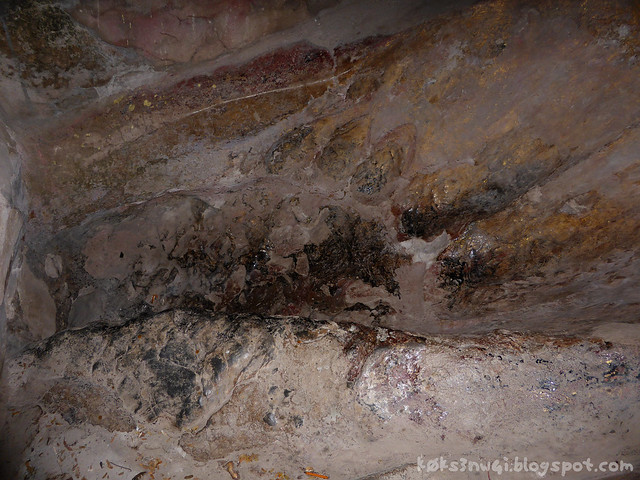 |
| The alleged mammoth footprint of Buddha housed in a little shrine. |
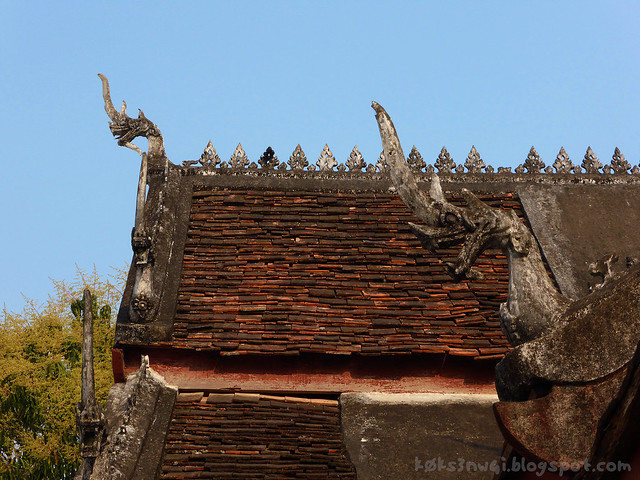 |
| Nagas or naks adorning the roofs of temples atop Phou Si. |
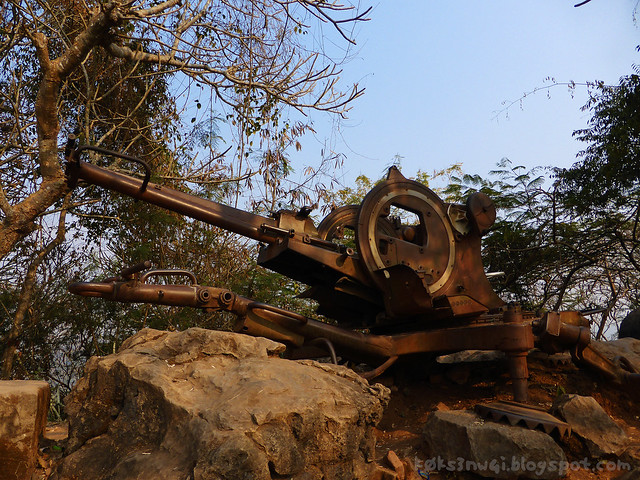 |
| Old wartime anti-aircraft cannon sitting in the middle of a Buddhist temple. Makes sense. |
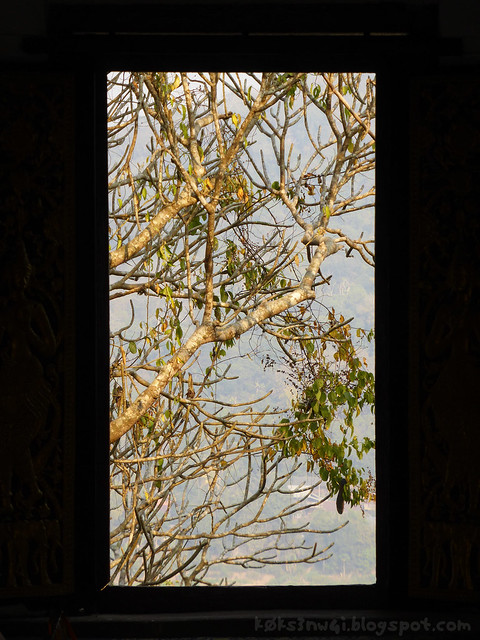 |
| The view through a window in one of the Phou Si temples. |
 |
| That Chomsi which crowns Mons Phousi. |
We noticed that there is a robust industry present in Luang Prabang selling captive sparrows in tiny bamboo cages for visitors to release in some sort of show of compassion to accrue merit (puñña) - which is the most wrongheaded, backward and hypocritical ritual imaginable! What sort of person can be stupid enought to miss the point so completely? To the credit of the European and American tourists, I saw none of them toting one of those tiny cruel sparrow cages while local and mainland Chinese tourists formed the majority of ignorami perpetuating the bird trade with their continued patronage.
 |
| Pointless cruelty for sale. |
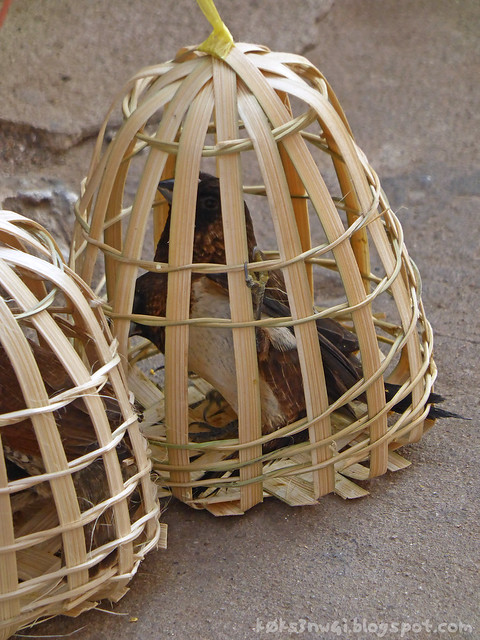 |
| A couple of birds belonging to a bunch of Chinese tourists. |
We didn't stay on Phou Si for very long because one can only take so many selfies with Buddha before one tires of the exercise. Buddha wouldn't be very much into it anyway since he always preached about anattā or "not-self", and that all concepts of individuality and ownership are illusory. Besides, a force of nature was churning in Cheryl's belly, compelling her make for the nearest commode. She wasn't amused when I started singing Frozen's Let It Go in an attempt to relax her sphincter.
 |
| The walk down Phou Si, on the north face of the hill. |
Reaching the bottom of the hill which bordered Rue Sisavangvong, the main street of Luang Prabang's historical quarters, we stumbled across what we felt had to be the most charming wat in Luang Prabang. A sign outside calls it Wat Pahouak and it appears to be in a state of advanced disrepair. The ornate wood cravings that adorn its frontal facade were denuded of colours, and the beautifully intricate and aged murals that covered the walls of its interior were peeling and faded. It's like a broken ride at Disneyland that had been operational when the theme park just opened and by that virtue, was infused with a great deal of nostalgia and authenticity.
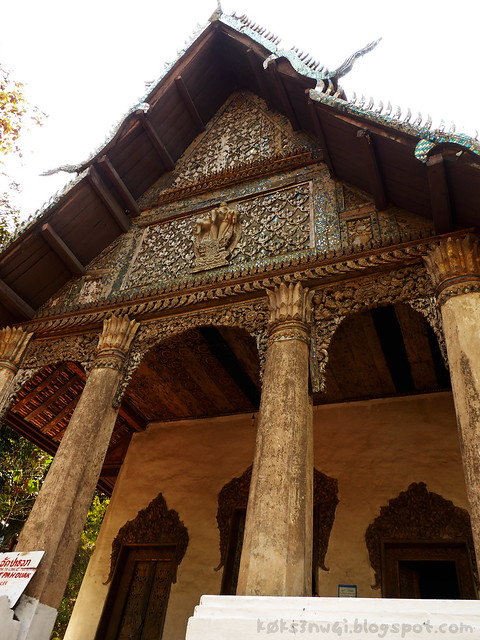 |
| The front of Wat Pahouak. |
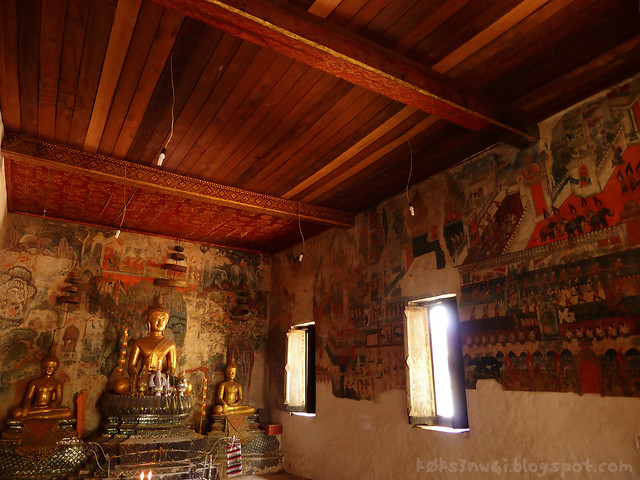 |
| The interior of Wat Pahouak. |
Haw Pha Bang
Crossing the Rue Sisavangvong from the charmingly dilapidated Wat Pahouak, we visited the Royal Palace Museum (Haw Kham) which served as the former abode of Luang Prabang's (and Laos') kings. As soon as you enter the opulent grounds lined with tall Palmyra Palms, your attention would immediately be drawn to the white, gold and emerald Royal Chapel (Haw Pha Bang) to your right.
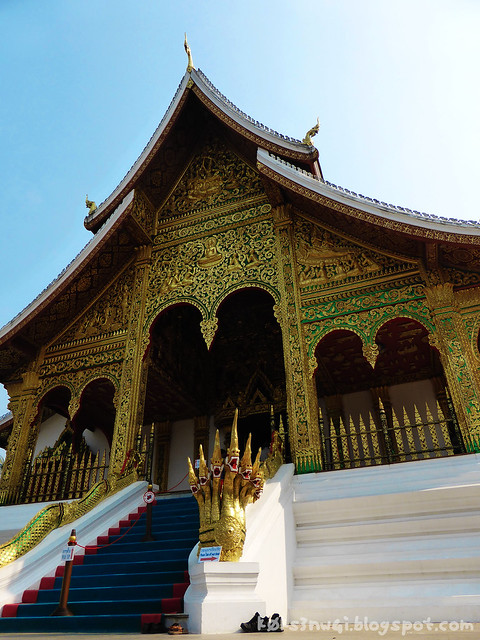 |
| Haw Pha Bang. |
 |
| Cheryl sitting on the steps of the Haw Pha Bang's posterior side. |
As excessively gorgeous as the Haw Pha Bang is, the real star attraction is what it protects within its halls: the holy Phra Bang.
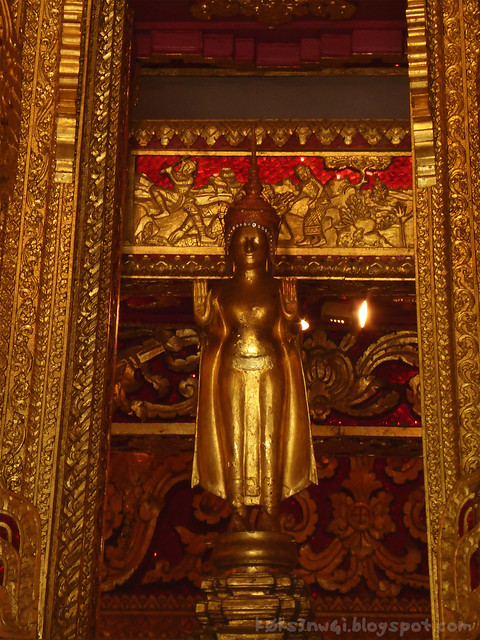 |
| The Phra Bang displaying Abhaya Mudrā. |
"Phra Bang" means "fine or delicate Buddha" and it is both the namesake of Luang Prabang (meaning "City of the Lord of Fine Gold") and the palladium of Laos. One can say that after the looting of the Emerald Buddha in Vientiane by Siamese forces, the Phra Bang became this country's most important relic. The figurine itself is a 83cm high standing Buddha that was cast in bronze and covered in gold leaf and was alleged to have originated from Ceylon (now Sri Lanka) between the 1st and 9th century however as the features of Phra Bang suggests like its distinctively Southeast Asian double-palmed dispelling fear mudra, it probably had later Khmer origins. The Siamese had apparently captured it twice and returned it in 1782 and 1867 because it was believed to be responsible for the coincidental political upheavals in Siam in those times.
Incidentally, one is allowed to stand right outside the Haw Pha Bang to view the Phra Bang but isn't allowed to take any pictures in its presence. A surly guard was posted in situ to make sure that that rule does not get flouted so the picture I snapped was taken from some distance away using my camera's zoom function. Hey, it's not like there isn't already a thousand pictures of it on the internet. Besides, it's also taken out on a procession on the 3rd day of every Pimai or Lao New Year.
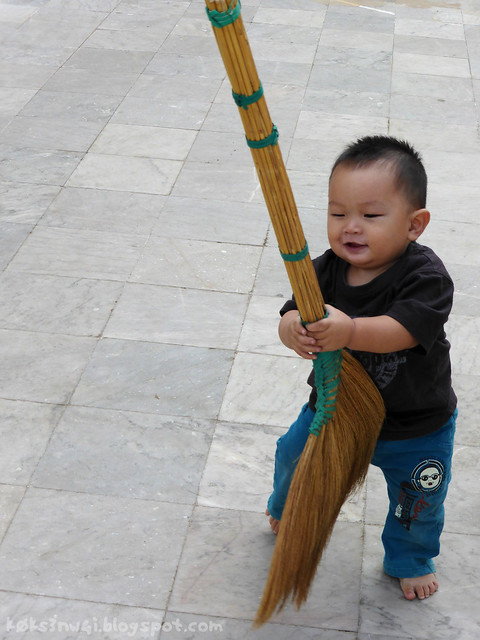 |
| A plump toddler playing with a broom right outside of the Haw Pha Bang. |
Haw Kham
After seeing the greatest treasure of the Lao people, Cheryl and I moved on to the Royal Palace itself which is designed and built in 1904 during the French colonial era with a mix of traditional Lao motifs and French Beaux-Arts. After the royal family was deposed of by communists in 1975 and were taken to re-education camps, the palace was converted into a national museum which either condemns or celebrates the luxury in which the royalties of Luang Prabang enjoyed (it's hard to tell).
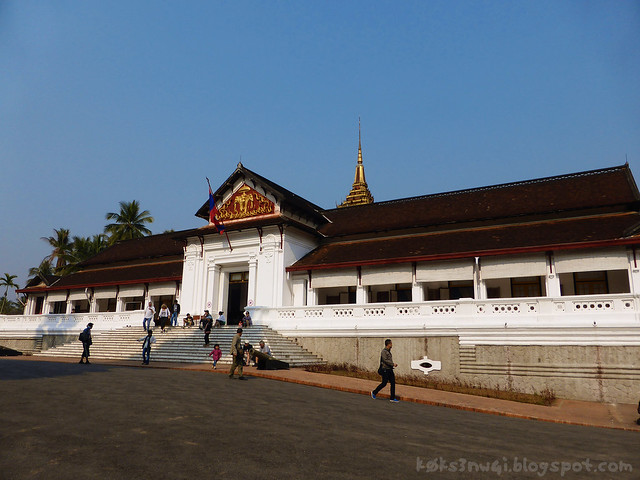 |
| The Haw Kham or Royal Palace. |
Cheryl was denied entrance initially because she was wearing shorts, presumably because they were afraid that her sexy legs will offend the imperial knick-knacks and antiques displayed here, so I was forced to shell out more money to rent a sȉn (an ankle-length Lao tube skirt) for her to enter a building she already paid admission to.
 |
| The King's bedroom. |
Skint as we were, we did not splurge on a guide for the tour (the money went into renting Cheryl's sȉn) but if you are so inclined, you can easily shadow any of the dozens of guides leading groups of Americans who enjoy asking questions about communism and then nodding smugly after receiving confirmation that their own country is superior.
After we were done with the palace proper, we went to the royal garage to check out the antique cars that the royal family owned, and most of the information plaques there declared them to be gifts from heads of states in other countries. Seriously, why do people who can actually afford to buy expensive cars get them for free?
 |
| Old timey royal cars. |
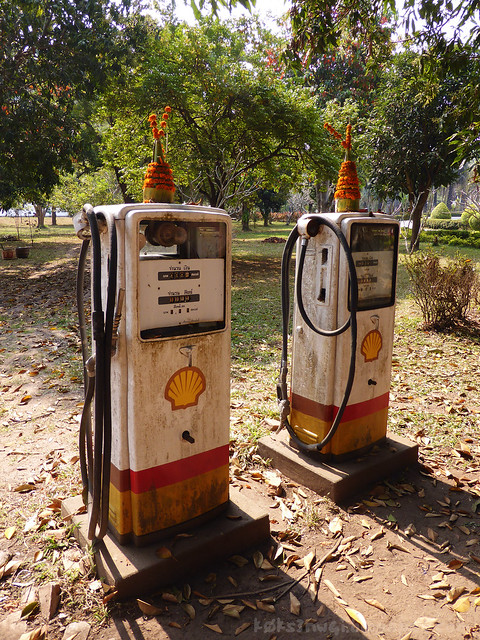 |
| Petrol kiosks found right outside the royal garage. |
There's also a supersized pond filled with fat, gluttonous koi fishes somewhere on the grounds. And this disapproving statue of Sisavangvong (or Sisavang Phoulivong) who was the king for whom the Haw Kham was built for.
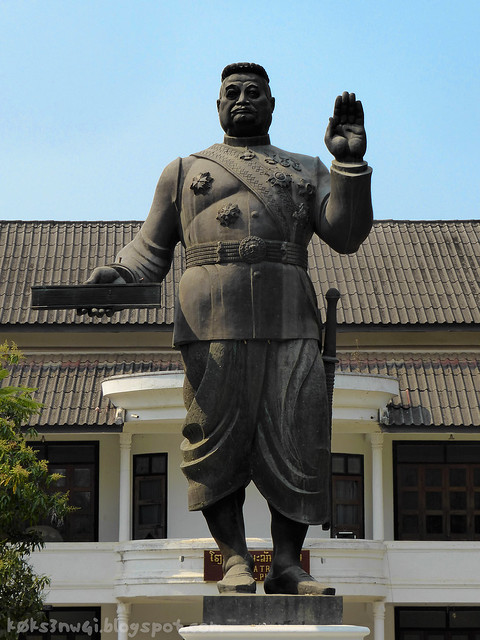 |
| "Harrumph." |
Wat Xieng Thong
We headed back to our guesthouse for Cheryl to pump (she's still nursing) and then ventured out again at lunchtime but this time, she put on a pair of long pants to avoid antagonising the Lao fashion police further. This time, we make our way northeast to the tip of the peninsula formed by the confluence of Mekong and one of its tributaries, the Nam Khan to see Wat Xieng Thong - one of the most iconic monuments to Lao spirituality and traditional Lane Xang Arts-style architecture. Its name means "Temple of the Golden City".
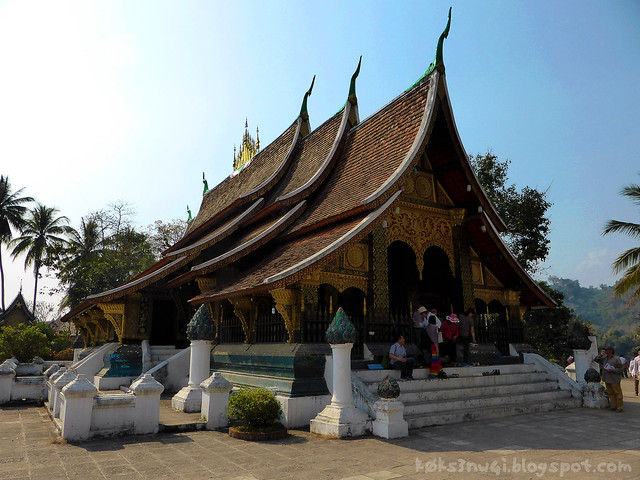 |
| The sǐm of Wat Xieng Thong. You can see Cheryl standing on its step wearing her rainbow hammerpants. |
The sumptuous sǐm with its elegant multi-tiered sweeping roof formed the centrepiece of the temple complex and it is also one of the oldest still-standing monuments of Luang Prabang which dates back to antiquity having been built in 1560, making it a contemporary of my own hometown's Porta de Santiago.
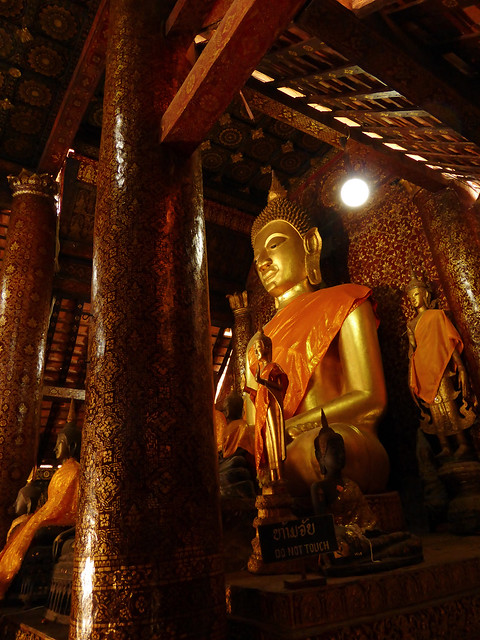 |
| CAN'T TOUCH THIS. |
Every inch of the interior was completely ornamented with detailed murals rife with some symbolism or other and what it lacked in the grandeur of size, it more than made up for it with sophistication (that most other temples in Laos lack).
Aside from the main sǐm, I would also recommend checking out the adjacent Haw Tai Pha Sai-Nyaat or Chapel of the Reclining Buddha which contained a unique reclining Buddha statue which went as far afield as France when it was exhibited at the 1931 Exposition coloniale internationale (Paris Colonial Exhibition) which was basically the French's way of showing off how many cultures they have subjugated and robbed at the time. The reclining Buddha eventually made its way back home in 1964. The chapel containing it is also known as La Chapelle Rouge or the Red Chapel for obvious reasons.
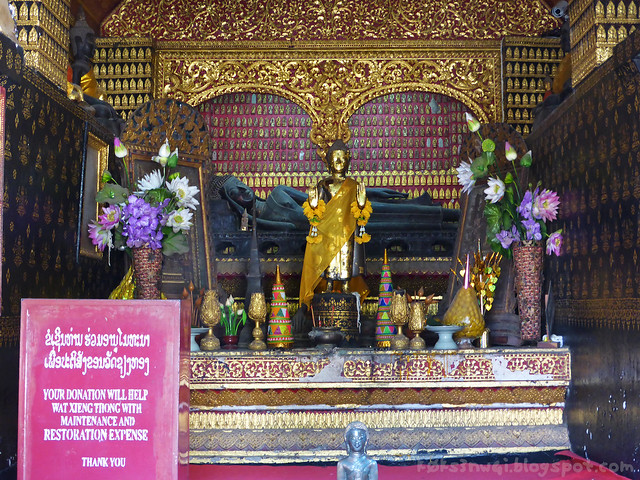 |
| DO NOT DISTURB. BUDDHA IS SLEEPING. |
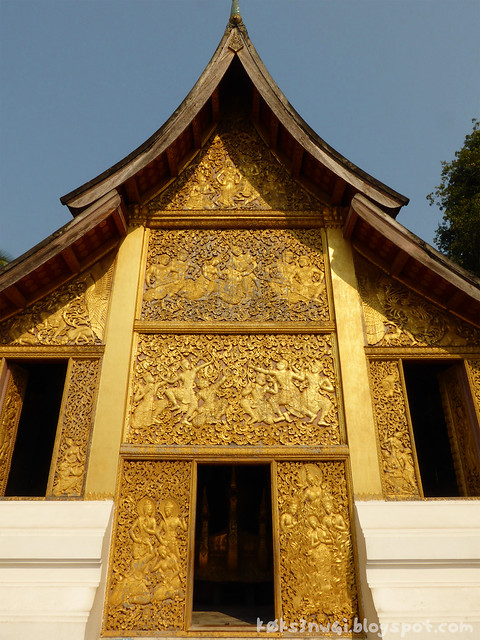 |
| The Hohng Kep Mien or carriage house, which houses a titanic funerary carriage within. |
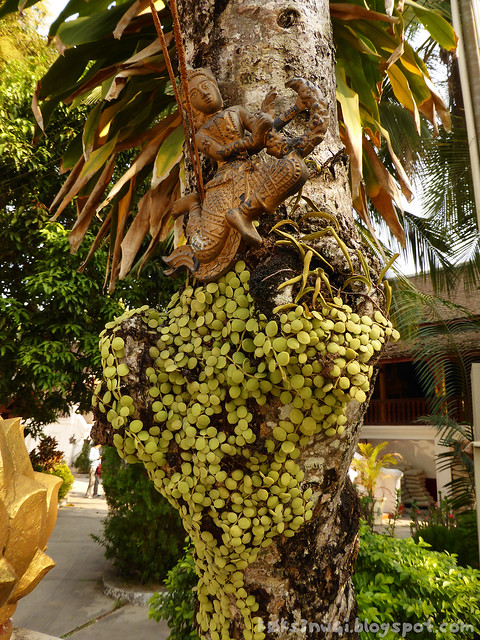 |
| Tree seen on the grounds of Wat Xieng Thong. |
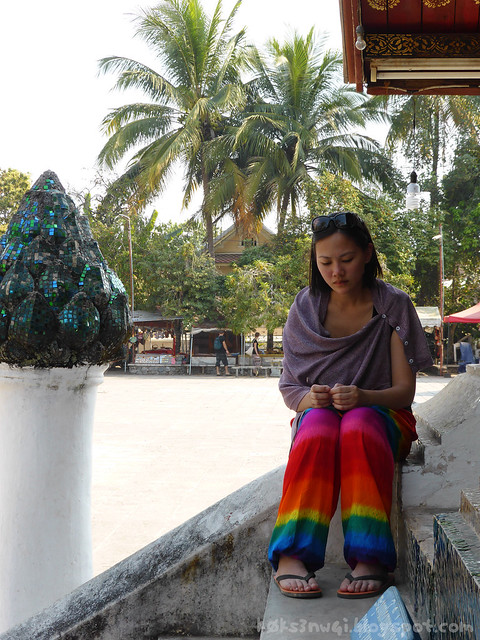 |
| Cheryl wearing her brand new rainbow-coloured hammer pants outside of Wat Xieng Thong's sǐm. |
Nam Khan and the Mekong by Night
That evening, we went back to the Handicraft Night Market and had our dinner at a roadside stall, but there's a lot more to that story so I am going to talk about that in my next travelogue. Cheryl considers that to be the worst decision she made in this entire honeymoon trip.
It was still early when we finished eating so we made our way to Rue Soulignavongsa which runs along the Mekong and parked ourselves at a riverside café where she had a coconut shake and I a piña colada, which I consider to be a quintessential holiday cocktail. I also had some frozen yoghurt while she had a Magnum chocolate bar all to herself. Then, we took our first picture together in this entire trip with the aid of my tripod.
 |
| Cheryl and I by the Mekong. |
We took the long way back to our guesthouse because it was such a pleasant night for a stroll. Before long, we reached the other coast of the peninsula which banks the Nam Khan. A jerry-built bamboo pedestrian bridge spans the shallow river to a poorly-lit semi-rural neighbourhood.
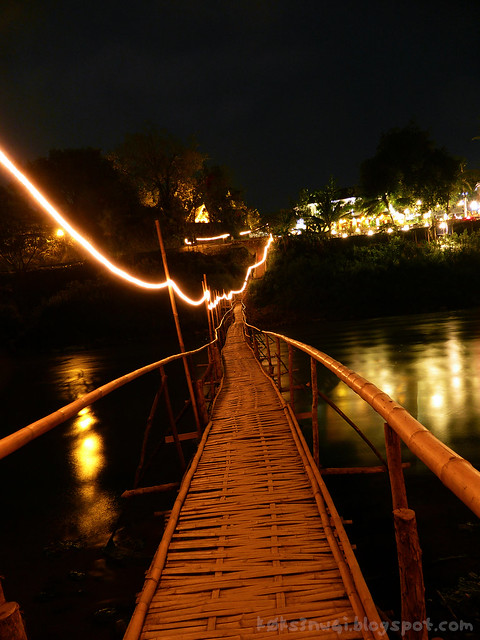 |
| Looking back to the city from across the Nam Khan. Inspire confidence, the bridge does not. |
 |
| View of the Nam Khan from the rickety bridge. |
The Night Market was already winding down by the time we made our way back to central Luang Prabang so we decided to turn in early as I intended to go hunting for alternative (and cheaper) accommodation tomorrow. Little did we know that that night, an unexpected and terrible fate would befall my wife and partner.
RELATED POSTS:
Vive La Vientiane: Part One
Veni, Vidi, Vang Vieng: First Night in Town
Veni, Vidi, Vang Vieng: Climbing Pha Ngeun
Veni, Vidi, Vang Vieng: The Blue Lagoon at Tham Phu Kam
Veni, Vidi, Vang Vieng: Solo Mountain Biking Trip to Kaeng Nyui Waterfall
Veni, Vidi, Vang Vieng: Tubing Down the Nam Song
Veni, Vidi, Vang Vieng: Last Day in Town at Pha Poak and Lusi Cave
Sabaidee Luang Prabang: The Night and Morning Markets
Sabaidee Luang Prabang: Out Alone in the City
Went to adult Disneyland,
k0k s3n w4i


No comments:
Post a Comment